L'Artisan Parfumeur Fleur de Liane (2008): Variation on the Eternal Feminine {New Fragrance} {Perfume Review}
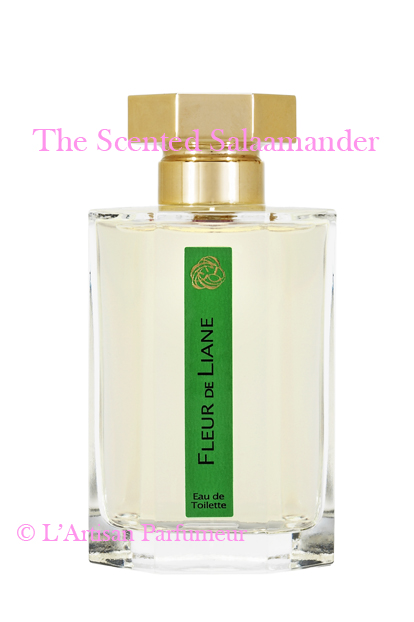
Fleur de Liane (Vine Flower) is a new upcoming scent by L'Artisan Parfumeur to be released this fall in September-October 2008. It was inspired by sensations gathered by perfumer Bertrand Duchaufour in the midst of a tropical jungle located on the island of Bahia Honda in Panama during the rainy season, during which time he reportedly also produced visual materials to nourish and accompany his vision for the scent such as photographs and watercolors.
The perfume is part of L'Artisan Parfumeur's collection of exotic, travel-inspired compositions called "Odeur volée par un parfumeur en voyage" (Stolen Aroma by a Perfumer on His Travels). The series already comprises Bois Farine by Jean-Claude Ellena, which inaugurated this particular library of perfumes in 2003, followed by Timbuktu and Dzongkha, also by Bertrand Duchaufour who has recently been hired as L'Artisan Parfumeur's in-house perfumer.
Duchaufour is noticeably looking more and more the part, his look having evolved from professional to edgy perfumer-artist. It is a reminder that perfumers are part of the branding strategies of perfume houses, like Jacques Polge for Chanel - a move that should accentuate itself as more and more perfumers are coming to the forefront of public attention...
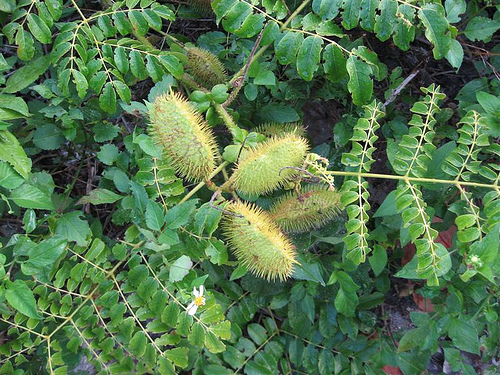
While the natural-world reference turned palpably into a mine of ideas for Duchaufour, and the greenness of the scent is its most realistic and atmospheric aspect, Fleur de Liane, as one realizes after a while, is named after a flower, imagined rather than copied, and this vague and compelling floral accord seems to be at the center of the perfume like an encounter with a beautiful and rare creature in the jungle giving isolated, singular meaning within the over-stimulation and excess of a green, vaguely confused and aqueous world.
One is of course tempted to ascribe sexual meaning to this showcasing, as the flower, the vine flower, seems to embody a feminine figure of desire in its uniqueness and centrality as well as the fascination it holds over the senses.
The structure of the perfume also suggests one of those huge floral or flower-like paintings by Georgia O'Keefe where the blooms or even a flower-like waterfall (as shown here) are like the sexes of women. Here the greenness is enveloping like the giant folded petals of an O'Keefe dream of a flower-sex and the vine flower itself is ensconced in its middle like an even more central sexual reference.
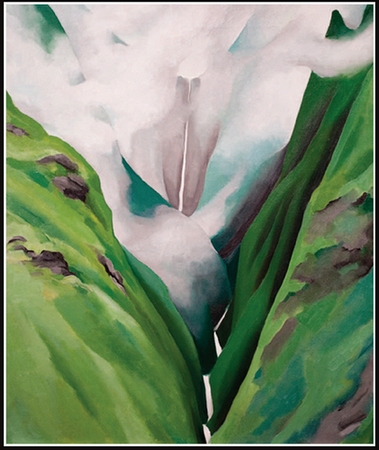
Fleur de Liane presents itself as a green vegetabley shrine encapsulating many other subtle nuances within its folds. The composition reveals a fresh green accord (it smells of galbanum lentisc and green coffee, among other things), sappy, fruity notes (in the direction of a very nuanced, slightly woody red lychee/ mangosteen note); there is, I must say, a more pedestrian passage or layer of construction resting in part on an oft-experienced green-floral accord found in mass-market and designer fragrances, like in White Shoulders, Flower by Avon-Cynthia Rowley or Fleur Défendue by Lolita Lempicka, which for a time makes the scent feel more prosaic; the perfume has also also woody and peppery facets; there is a hint of creamy banana; it is grassy (not in a mown-lawn way, more like in a beaten-fiber way). Finally, it is also very realistically watery.
The general main impression at first, and the most obvious one, is that of a composition that aims to capture different nuances of green colors and aromas, playing with light, as felt under a thick canopy of trees letting through more or less external light in the rainforest (probably not) or jungle. This is however followed by a central passage in which the perfume turns into a seeming soliflore showcasing a criminal tropical flower that is at once waxy, creamy, sweet, indolic, and abstract. There is a tenuous link to Black Orchid by Tom Ford, for people who know this perfume, in the rendition of this jungle flower in its indolic cheese-like facet, which is much more faint in this case, and mostly, it feels intriguing, original and seductive. The list of notes gives marigold, tuberose and magnolia as three of the building-blocks of this more perfect flower. The dry-down smells of tonka then clear mineral water (to me Tonka bean has always presented a water facet). The transparent mineral aspect of the water is very perceptible. It becomes also more distinctively Ozonic with time. The longer dry-down is warmer, amber-y and musky in an understated way.
Each testing of the composition reveals new nuances such as more hidden, characteristic aqueous facets among the green notes, as opposed to raw liquid sappy ones. The perfume also plays with luminosity, the mid-course stage being the most citrus-like one. The soft woody impression seems to rest in part on iris.
Fleur de Liane is a convincing postcard sent from Bahia Honda. It is a composition that mixes realistic and more abstract references and is very layered, a little like a millefeuilles. If you think of it as a tropical perfume, it is a very different and much more sophisticated take on the idea. If you think of it in stylistic terms, it appears more to belong to a school of perfumery that will feel familiar to fragrance aficionados and of which L'Artisan Parfumeur is a prime example, bringing together a minimalist streak and a sophisticated naturalistic reference; one thinks of a literary equivalent like the Nouveau Roman school of literature. The aesthetics are definitely modern and uncluttered, streamlined although it is also a sensitive and subtle composition. Poetically, Fleur de Liane succeeds in inventing an unknown flower that is like a dream, vague and distant, yet alluring with its soft tentacles extending toward you.
Photo and some information via L'Artisan Parfumeur press release







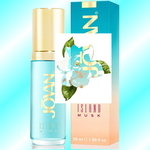
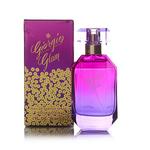

Ah! I adore the concept of an invented flower, and Comme des Garcon #3's invented chrome neon blossom is one of my favorites. A deep enveloping green sounds beautiful. The grip of vines is a lovely conceptual starting point for the embrace of fragrance.
I am not actually meaning that this was the perfumer's intention (the grip of vines, cf. last image) but it is my interpretation :)
Yes, the invented-flower motif seems to be a more willed proposition than the abstract flower one. The invented flower is showcased very well in Fleur de Liane, more perceptibly so than in the upcoming Kenzo Power where it tends more toward abstraction, to my nose.